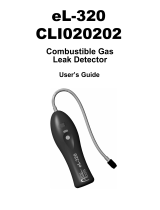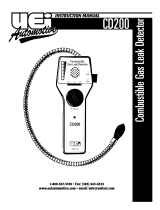Page is loading ...

CONTENT Page
1. GENERAL INFORMATION ------------------ 2
2. FEATURES ---------------------------------------- 2
3. SPECIFICATION --------------------------------- 3
4. OPERATION GUIDE --------------------------- 4
5. PART & CONTROL------------------------------ 5
6. GETTING STARTED---------------------------- 7
6-1 Installing Batteries---------------------------- 7
6-2 Automatic Circuit/Reset Feature--------- 8
6-3 Feature Sensitivity Adjustment---------- 9
7. OPERATING PROCEDURE----------------- 9
8. REPLACING NEW SENSOR-------------- 11
9. CLEANING --------------------------------------- 12

COMBUSTIBLE GAS DETECTOR
2
1. GENERAL INFORMATION
Thank you for purchasing Combustible Leak Detector.
Read though the instruction manual before operation
for correct and safe usage. Please store and retain
this instruction manual for future reference.
2. FEATURES
Combustible Leakage Detector is extremely useful as
a general purpose tool in any environment where
gasoline, propane, natural gas or fuel oil is used. This
unit uses a newly developed semi-conductor sensor
which is extremely sensitive to variety of general
used combustible.
§ Microprocessor Control with advanced digital
signal processing.
§ Multi color visual display.
§ High-Low leak sensitivity selector.
§ Low battery indication.
§ Semiconductor gas sensor.
§ Detection of combustible gas.
§ Carrying case included.
§ 15.5” (40 CM) flexible stainless probe.
§ Reference Leak source included.
§ Ambient concentration reset.
Application:
§ Detect leaks in automobile exhaust and fuel
system.
§ Detect leaks in liquid or gas fired heating systems.
§ Safety checks at propane filling stations.

COMBUSTIBLE GAS DETECTOR
3
§ Search for arson residue (detects accelerants).
§ Detect fuel in marine bilges.
§ Check manholes/sewers for safety.
§ Check for cracked heat exchangers.
§ Detect solvent residue.
3. SPECIFICATION
Detectable Gases:
Gasoline, propane, natural gas or fuel oil.
Alarm Method:
Buzzer, Tricolor LED bar Indicator.
Sensitivity: Variable, as low as 5ppm(gasoline)
Power Usage:
4 AA size (6V DC) Alkaline Batteries
Snake Tube length: 40cm (15.5”)
Dimension / Weight:
173 x 66 x 56 mm (approximately 400g)
Accessories:
Alkaline batteries (AA) X 4 pcs
User manual, leak check bottle, carry case.
Battery Life:
Approximately 40 hours normal use.
Auto power OFF: 10 minutes
Warm-Up Time: Approximately 90 seconds
Operating Temperature & Humidity:
0 ~40 °C, < 80% RH

COMBUSTIBLE GAS DETECTOR
4
Storage Temperature & Humidity:
-10 ~60 °C, < 70% RH
Altitude: < 2000M (6500’)
4. OPERATION GUIDE
(1) The combustible leak detector unit is not equipped
with anti-explosive designs and measures. Do not use
this unit in the environment with the burnable gases.
(2) There are some environmental conditions that
might cause error reading:
§ Pollutant places.
§ Large temperature variation.
§ Places with high wind velocity.
§ Organic solvent, adhesive vapor, fuel gas and
vesicant will cause abnormal response from the
sensor. Try to avoid the environment involved with
this substance.
§ Places fill with too much to combustible Gas.
Note: Although the unit will respond to high levels of
carbon monoxide, it should not be used as a detector
for this gas in normal room or working atmospheres.
It is used to pinpoint a leak as described in the
operating instruction.

COMBUSTIBLE GAS DETECTOR
5
5. PARTS & CONTROL
5-1 Panel Description
○,9
COMBUSTIBLE
GAS DETECTOR

COMBUSTIBLE GAS DETECTOR
6
○,1 Sensor ○,2 Sensor Protector
○,3 LED Leak Indicators ○,4 Sensitivity Lo Button
○,5 Sensitivity Hi Button ○,6 Low Battery Indicator
○,7 Power On/Off & Reset Button
○,8 Battery Cover ○,9 Battery Cover Screw
5-2 LED Leak Indicator Definition:

COMBUSTIBLE GAS DETECTOR
7
6. GETTING STARTED
6-1 Installing Batteries
§ Loose the screw and remove the battery
compartment door located on the bottom of the
instrument as shown below (Fig.1).
§ Install 4 “AA” size alkaline batteries.
§ Reinstall the battery cover by aligning it with the
handle.
When the battery power is running low, the Red LED
Low Battery indicator illuminates. The batteries should
be replaced as quickly as possible.
4 “AA” size
alkaline batteries
Fig.1

COMBUSTIBLE GAS DETECTOR
8
6-2 Automatic Ambient Reset Feature
This combustible leak detector features an Automatic
Ambient Reset function that sets the unit to ignore
ambient concentrations of combustible.
§ Automatic Ambient Setup - Upon initial power on,
the unit automatically sets itself to ignore the level
of combustible present at the tip. Only a level, or
concentration, greater than this will cause an alarm.
CAUTION!
Be aware that this feature will cause the unit to
ignore any combustible present at turn on. In other
words, with the unit off if you place the tip up to a
known leak and switch the unit on, no leak will be
indicated!
§ Ambient Reset Feature - Resetting the unit during
operation performs a similar function; it programs
the circuit to ignore the level of combustible
present at the tip. This allows the user to 'home-in'
on the source of the leak (higher concentration).
Similarly, the unit can be moved to fresh air and
reset for maximum sensitivity. Resetting the unit
with no combustible present (fresh air) causes any
level above zero to be detected.

COMBUSTIBLE GAS DETECTOR
9
6-3 Feature Sensitivity Adjustment
The Instrument provides two levels of sensitivity.
When the unit is switched on, it is set to the high
sensitivity level by default.
§ To change the sensitivity, press the key.
When the key is pressed, the visual display will
momentarily show the two left LED's (green)
indicating Low Sensitivity level is selected.
§ To switch back to High Sensitivity, press the
key. The two right LED's (red) will light momentarily
indicating high Sensitivity level is selected.
7. OPERATING PROCEDURE
WARNING!
1. Do not use the instrument in an area of
extremely high level of combustible gas.
2. The gas/vapor of organic solvent might
interfere with the function of the unit. During
detection, please eliminate the influence of the
organic solvent.
3. In order to ensure correct operation and
indication, the unit should be switched on and
warm-up in non-contaminated atmosphere.

COMBUSTIBLE GAS DETECTOR
10
l How to Find Leaks?
NOTE: A sudden whipping of the leak detector probe
or "blowing" into the sensor tip will affect the air flow
over the sensor and cause the instrument to alarm.
(1) Power-Up & Reset function key:
The key turns the combustible leak detector
instrument ON or OFF and reset function.
Press it once to turn on the combustible leak detector,
the display will illuminate with flash, for 1.5 minutes to
heat up the sensor.
Press it again to reset the ambient base concentration.
Press and hold this button for 5 second to turn OFF the
power.
(2) Verify the condition of the unit and sensor:
§ Set the sensitivity level to “Hi”.
§ Open the leak check bottle cover and slowly move
it closer to snake tube nozzle.
§ If the indication moves up to high from low then we
should move the check bottle away and the LED
should go off again. This shows that the unit is
under working condition.
§ If the unit does not perform as we expect, bring the
unit for maintenance at your local sales office.
(3) Enter the Measuring Mode
§ Place the tip of the leak-detector probe as close as
possible to the site of the suspected leak. Try to
position the probe within 1/4 inch (6 mm) of the

COMBUSTIBLE GAS DETECTOR
11
possible leak source.
§ Slowly move the probe past each possible leakage
point.
§ When the instrument detects a leak source, the
audible tone will alarm. Additionally, the visual
indicators will light from left to right; Green LED
then Orange LED then Red LED (highest
concentration) as increasing of level indicate that
the location is close to the source.
§ When the Instrument signals a leakage, pull the
probe away from the leak for a moment, and then
bring it back to pinpoint the location. If the
combustible leak is large, setting the sensitivity
switch to LOW will make it easier to find the exact
site of the leak.
§ Return the sensitivity switch to HIGH before
searching for additional leaks.
§ When you've finished leak-testing, turn OFF the
instrument and store it in a clean place, protect the
leak detector from possible damage.
8. REPLACING NEW SENSOR
The sensor has a limited operative period. Under
normal operation, the sensor should work more than
one year. Expose the sensor under high density of
coolant (>30000ppm) will shorten its life cycle rapidly. It
is important to ensure that sensor surface is free from

COMBUSTIBLE GAS DETECTOR
12
Sensor
Sensor protector
water droplets, vapor, oil, grease, dust and any or all
other forms of contaminant. Furthermore, to ensure
good working condition of the unit, sensors must be
replacement periodically when its operative life is over.
WARNING! When replacing new sensor,
the worn-out sensor may be HOT!!
(1) Remove cone cap cover from the tip of snake tube.
(2) Pull out old sensor and insert the new sensor into
the plug (see below fig.2).
(3) Seal the cap cover over the plug.
Fig.2

COMBUSTIBLE GAS DETECTOR
13
9. CLEANING:
The Instrument plastic housing can be cleaned with
standard household detergent or isopropyl alcohol.
Care should be taken to prevent the cleaner from
entering the instrument. Gasoline and other solvents
may damage the plastic and should be avoided.
WARNING!
The detergent or isopropyl alcohol might
damage the sensor, please keep then from the
sensor through the process.
/


